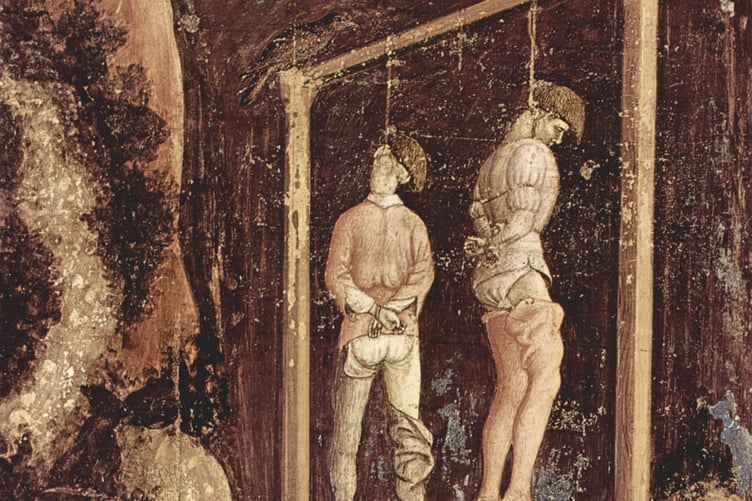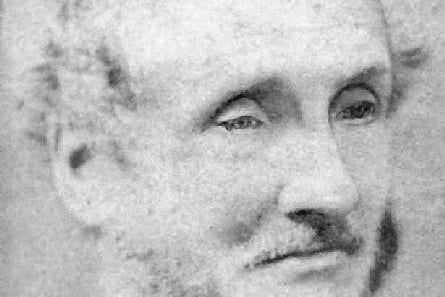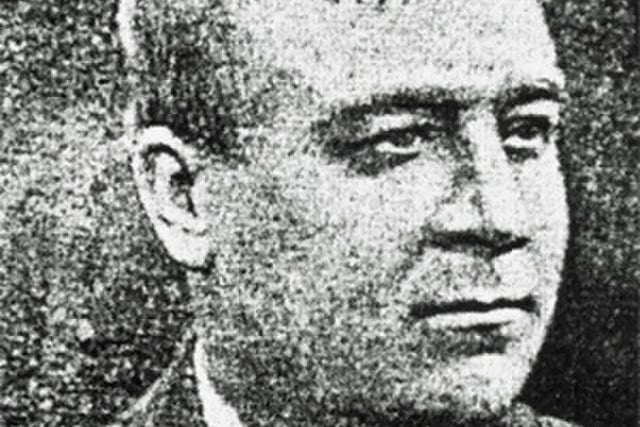WHEN James Gibbs was brought before the Monmouth Assizes to stand trial for murdering his wife Ann, he knew his prospects were bleak. The jury was told how Gibbs, renowned as something of a ladies' man, had viciously slashed his wife’s throat and discarded her bloodied corpse in a country ditch, just so he could be with his fancy woman.
When police discovered Ann’s rotting remains three weeks later, there was not much left of the woman whom Gibbs had been married to for under a year. Amidst the terrible stench of decay and writhing maggots that covered her rotting flesh, the police noticed something that literally glittered with the promise of revealing the identity of the killer - a gold watch.
The timepiece was engraved Ann Gibbs and the boys in blue thought it strange how the murderer would have left behind such a revealing and valuable trinket. They took the unusual decision to leave the body where it lay and stake out the murder site in the hope that the guilty party would return. Their gamble paid off. In the dead of night the person they were looking for returned. They had caught James Gibbs red-handed.
Mr. Justice Lush agreed it was an open and shut case. He also agreed that an eye warranted an eye. Donning the black cap and gloves of the hanging judge he looked an ashen-faced and trembling Gibbs square in the eye and said the words which have stilled the blackest of hearts.
“The sentence of this court is that you will be taken from here to the place from whence you came and there be kept in close confinement until August 24, 1874, and upon that day that you be taken to the place of execution and there be hanged by your neck until you are dead. And may God have mercy upon your soul.”
Gibbs’ death sentence was historic because he was condemned to be hanged at Monmouthshire’s major prison, Usk. Before that point, Usk had never been a hanging prison and it was a change that did not sit well with the population both within and outside those unforgiving walls.

From Anglo-Saxon times until its abolition in 1964, hanging was Britain's chief form of execution. Between 1735 and 1964 England and Wales bore witness to 10,935 civilian executions. On May 26, 1868, Fenian Michael Barrett was the last man to be lynched in public in the UK. Two days later a law was passed that Capital Punishment was now to be only carried out behind prison walls.
Six years on and for the first time in its history Usk prison had become a place of execution. Justice came at a high cost. Gibbs protested his innocence to the end but to little avail. On the day of his execution, the wretched soul was heard sobbing bitterly as the cold dawn added a little grey light to the night skies. When the prison Chaplain began the service for the dead and began solemnly pronouncing, “I am the resurrection and the life….” Gibbs's muffled lament turned into a howl of despair. His tortured cries reverberated throughout the prison. Both inmates and warders sat silent and still in grim contemplation of the harrowing futility felt by a man who knows with absolute certainty that the end of all things is nigh.
By the time he reached the black-painted scaffold, Gibbs's legs had betrayed him. He was carried onto the platform and placed upon the trap door. Trembling and sobbing with his arms tied tight behind his back he was asked if he had any last words. He replied, “God forgive my sins. He knows I am innocent and am happy. He knows I die innocent. Goodbye, my parents, goodbye all. May the Lord have mercy upon me.”
The Lord’s eyes were elsewhere. However, the hangman William Marwood was firmly focused on the task at hand. With polished practice, he quickly placed the hood over Gibb’s head. Tightened the noose around his neck, took a nimble step back, and routinely pulled the lever as Gibb fell and was left to dangle until dead.

Murder, whether committed by the individual or the state is a gruesome affair. Gibbs was the first of seven hangings to take place at Usk between 1874 and 1922, and one in thousands that have taken place in the name of justice across the UK. Hangmen such as Henry Pierrepoint, John Ellis, William Marwood, and James Billington, who all visited Usk, were seen by the general public as men of duty with a hard job to do. Although they were appointed by law to carry out the court’s ultimate verdict, hangmen were regarded as a curious breed who answered a curious calling compared to all the other cogs in the justice system such as judges, lawyers, policemen, and prison warders.
As a child, James Billington was obsessed with hanging. He could often be found carrying out executions on dolls and dummies. After a stint as a miner, a wrestler, and a pub singer, Billington became a teetotaller and Sunday school teacher and dedicated himself to execution with a single-minded pursuit. In the course of his career, Billington hanged 147 people, one of whom was Thomas Edwards, who murdered Abergavenny’s, Mary Connolly.
Billington was emotionally detached from the job at hand, when prisoner Joseph Laycock asked the man who was about to execute him if it would hurt, the hangman simply replied, “No, thou will never feel it, for thou will be out of existence in two minutes.”
Three of Billington’s sons would also follow in their father’s footsteps after picking up the rope and heading to the gallows to hand out a bit of state-sponsored justice.

William Marwood on the other hand developed a morbid interest in hanging late in life. The former shoemaker hung his first man at the age of 54 but also earned a reputation as a humane hangman for his invention of the long-drop technique. Before Marwood’s Victorian innovation, the hanging rope was usually only three feet in length. This entailed that slow and painful strangulation was normally the cause of death and not the more merciful and instantaneous snapping of the spinal cord. Marwood believed in execution and not torture. By lengthening the rope between six to ten feet he believed the condemned would be saved from the horror of dancing the Tyburn jig at the end of the rope as the life was slowly choked out of them.
However, not all of Marwood’s executions went to plan. The killer Vincent Walker was said to have writhed in agony for nearly ten minutes as he passed from this world to the next.
Marwood visited Usk on two occasions. The first was to hang James Gibbs in 1874 and the second was to send Joseph Garcia to the cold of the grave in 1878. On the first occasion, Marwood demanded that a three-foot pit beneath the gallows be dug out to accommodate the extra drop. Upon his second visit, he noticed the pit had become waterlogged and needed to be drained. In 1902 the problem was solved indefinitely by erecting the gallows in the prison itself. The space chosen was directly opposite the condemned prisoner’s cell. Whether by accident or design, the experience of watching the instrument of their demise being assembled must have been a particularly poignant punishment.
Yet no matter how steely the resolve or steady the nerve, the taint and stain of cold-blooded butchery was bound to take its toll on the most hardened state-appointed hangman.
For 23 long years, John Ellis wore the cap of an official executioner. It was a role that never seemed to sit well with him. Riddled with anxiety and stress before, during, and after the hanging, the mild-mannered Rochdale barber who executed such notorious criminals as Dr. Hawley Crippen regarded the executioner’s role as a sacred duty that needed to be carried out as efficiently and painlessly as possible.
Lacking the level-headed practicality of the likes of William Billington, who described his colleague as “always nervous and worried,” Ellis was particularly against the hanging of women. Yet when the time came for him to do his duty and escort a semi-conscious and distraught Edith Thompson to the gallows, he didn't falter. Thompson hadn’t murdered her husband but had been found guilty of aiding and abetting her lover who carried out the dark deed. Her execution haunted Ellis and may have been partially responsible for his resignation from his post not long after hanging a second woman, Susan Newell in Glasgow in 1923.
A year previously Ellis paid his first visit to Usk to execute the killer of Margaret Thomas, William Sullivan, who was the last person to be hanged at Usk.
A lifetime spent in the shadow of death caught up with Ellis. After tightening the noose around 134 killers, he began to drown himself in alcohol and turned the tools of his trade upon himself. His first attempt upon his own life was unsuccessful and a local magistrate gave him a firm reprimand to pull himself together. Unfortunately, Ellis was bent too far out of shape for that. On September 20, 1932, he carefully took a razor, and with his trademark neatness slit his own throat from end to end as both the life and despair bled out of him. Ellis had been executed by a hand whose unnatural familiarity with, and close and prolonged proximity to death had ultimately, proved its undoing.
On one occasion at Chelmsford prison, Ellis was once assistant to a man whose name looms large in the domain of public executions - Henry Albert Pierrepoint. Known simply as Harry to his friends and family, Pierrepoint once wrote, “I love my work on the scaffold.” He was also riddled with jealousy that Ellis would knock him off the top spot as the number one hangman. He snarled, “If I ever meet Ellis I’ll kill him - it doesn’t matter if it’s in the church!”
When Ellis and Pierrepoint finally came face to face on July 18, 1910, the afternoon before they were due to hang Frederick Foreman, the callous killer of his girlfriend Elizabeth Ely, it didn’t end well. Pierrepoint who had hanged William Butler at Usk four months previously was in his cups. It didn’t sit well with Ellis that an executioner of the state should hold themselves in such a drunken and undignified manner and he told him in no uncertain terms to behave and conduct himself with the standing and gravitas which his role warranted.
Such a reprimand from a man he regarded as his junior was like a red rag to a bull for Pierrepoint who launched a volley of verbalistic vitriol in Ellis’s face. He then physically attacked Ellis with a flurry of blows and the raging and roaring hangman’s assault only ceased when he was dragged off his fellow executioner by the prison staff.
On the morning of the execution, the two men were professionalism incarnate. The hanging was as polished and perfected as any they had conducted. Unfortunately for Pierrepoint, the authorities had got wind of his conduct and he was shortly told his services were no longer required by the state. Ultimately Ellis did prove his undoing but not in the way Pierrepoint envisaged.
Pierrepoint’s legacy lived on his son whose fame made him a household name. Between 1932 and 1956, Albert Pierrepoint earned a reputation as the most prolific and proficient executioner of modern times. He sent over 200 Nazi war criminals into the abyss at Nuremberg and served as the cold hand of justice in the hangings of some of Britain's most notorious killers.
Yet after 24 years and over 450 hangings, Pierrepoint wrote in 1974, “Hanging is said to be a deterrent. I cannot agree. There have been murders since the beginning of time, and we shall go on looking for deterrents until the end of time. I have concluded that executions achieve nothing.”





Comments
This article has no comments yet. Be the first to leave a comment.